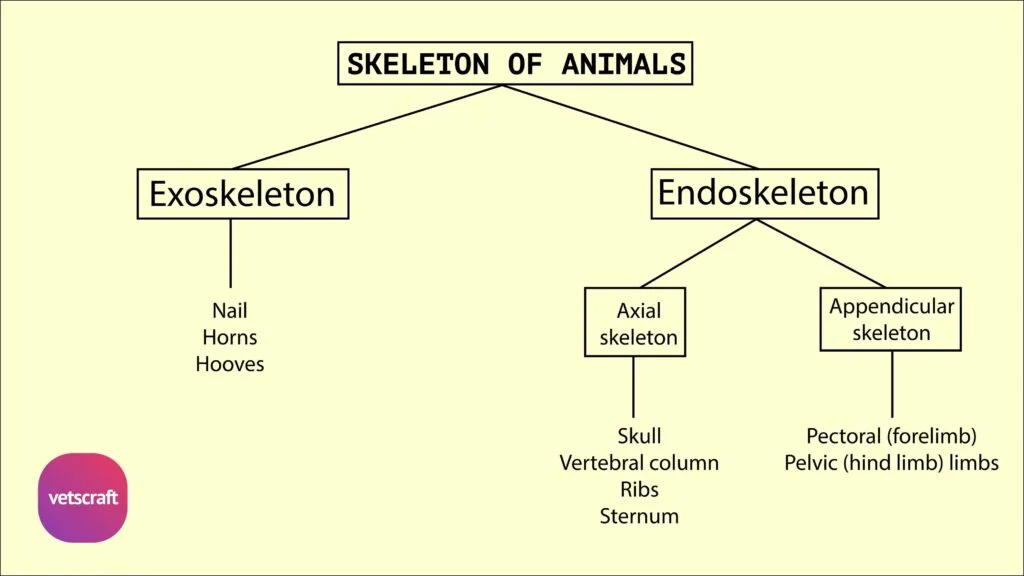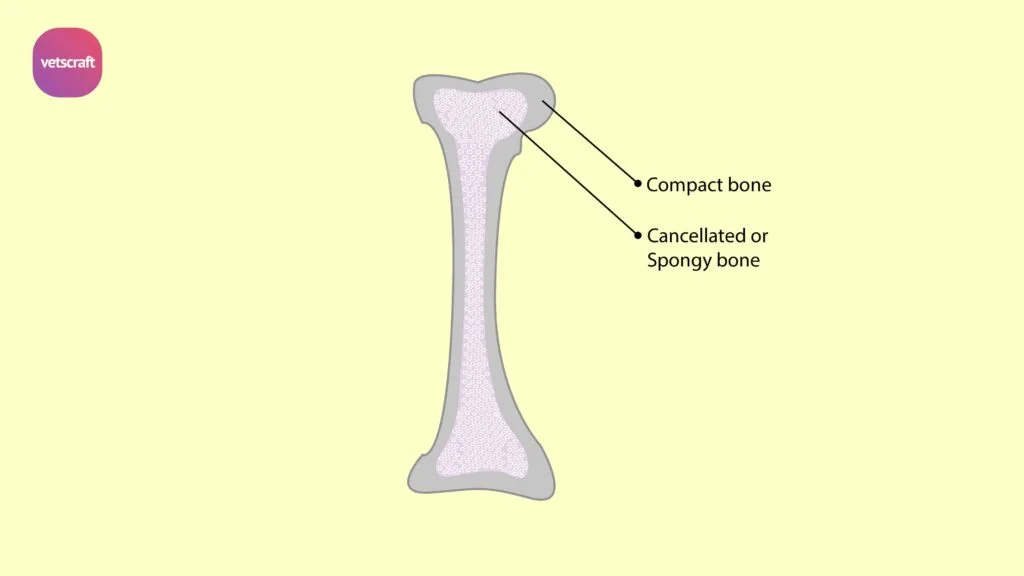TABLE OF CONTENTS
Anatomy of Os Coxae (Hip Bone) in Animals
The os coxae is commonly known as the hip bone. It is a large, flat, and irregularly shaped bone that forms the lateral and ventral walls of the pelvic cavity in vertebrates.
In domestic animals, it is composed of three fused bones — the ilium, ischium, and pubis — which unite at a central socket called the acetabulum, where the head of the femur articulates.
Os Coxae of Ox
The os coxae, or hip bone, consists of three flat bones: the ilium, ischium, and pubis, which fuse together to form the acetabulum. The ilium extends from the acetabulum upwards, forming the lateral wall of the pelvic cavity. The pubis and ischium extend medially and backward, respectively, and their medial borders fuse with those of the opposite side to form the pelvic or ischio-pubic symphysis.
The pubis and ischium form the anterior and posterior parts, respectively, of the floor of the bony pelvis and enclose between them, on each side, a large obturator foramen.


Ilium
The ilium of the ox is the largest of the three parts. It is irregularly triangular, being wide above, narrow and prismatic at the middle, and slightly expanded below. The ilium presents two surfaces, three borders, and three angles.
The lateral or gluteal surface is directed dorso-laterally and backward. The inferior third of this surface presents rough lines for the origin of the gluteus profundus. This surface is traversed by the gluteal line, running nearly parallel to the cotyloid edge from a little below the tuber coxae to become continuous with the ischiatic spine. This surface serves for the origin of the gluteus medius.
The medial or pelvic surface presents a rough triangular medial part—the sacral surface—and a smooth quadrilateral part—the iliac surface. The former presents an irregular facet, the articular surface for the sacrum. The iliac surface is directed forward and is covered by the iliacus. The ilio-pectineal line, which separates these two surfaces, begins below the articular surface and joins the anterior border of the pubis and forms the lateral boundary of the pelvic inlet. It bears, about the middle, the psoas tubercle for the psoas minor.
The cotyloid border leads to the acetabulum, a little above and in front of which are two depressions (the lateral one is faint) for the origin of the rectus femoris.
The ischiatic border is concave and forms the greater ischiatic notch. The notch forms the greater ischiatic foramen, which is covered by the sacro-sciatic ligament in life and serves for the passage of gluteal nerves and anterior gluteal vessels. In its lower part, it is convex, rough, and is continuous with the ischiatic spine, which gives attachment to the sacro-sciatic ligament at its free edge and to the gluteus profundus on its lateral aspect.
The dorsal border, or the crest of the ilium, is concave, thick, and rough for the attachment of the muscles of the loin.
The medial angle, or tuber sacrale, is separated from its fellow and forms, with it and the sacral spines, the point of the croup.
The lateral angle, or tuber coxae, is large and prominent, wide in the middle and smaller at either end, and serves for the attachment of the iliacus, obliquus abdominis internus, tensor fasciae latae, gluteus medius, etc.
The inferior or acetabular angle is thick and meets the other two parts at the acetabulum.
Ischium
The ischium of the ox is smaller than the ilium. It is irregularly quadrilateral and placed behind the ilium and the pubis. It has two surfaces and four borders.
The dorsal pelvic surface is slightly concave transversely and forms the posterior part of the pelvic floor.
The ventral surface presents, about its middle, a rough ridge for the biceps femoris. It is roughened for the origin of the adductor muscles of the thigh. The anterior border is concave and forms the posterior boundary of the obturator foramen.
The posterior border slopes forward and downward and meets the same border of its fellow to form the ischial arch, which constitutes the inferior boundary of the pelvic outlet.
The medial border, with its fellow, forms the ischiatic symphysis and presents, ventrally, a ridge which gives attachment to the suspensory ligament of the penis in the male and that of the udder in the female.
The lateral border is concave and forms the lesser ischiatic notch and is continuous with the ischiatic spine. The notch forms the lower boundary of the lesser sciatic foramen, bordered above by the sacro-sciatic ligament (in life), which allows passage of the posterior gluteal vessels.
The antero-lateral angle joins the ilium and the pubis at the acetabulum.
The postero-lateral angle, the tuber ischii, is a trifid process and serves for the origin of the biceps femoris, semitendinosus, and semimembranosus.
Pubis
The pubis bone of the ox is the smallest of the three parts. It is irregularly triangular and has two surfaces and three borders.
The dorsal or pelvic surface forms the anterior part of the pelvic floor, and the urinary bladder rests on it in life.
The ventral surface is rough for muscular attachment.
The anterior border is thick. Laterally, it bears the ilio-pectineal eminence and curves for the attachment of the prepubic tendon.
The posterior border forms the anterior margin of the obturator foramen.
The medial border meets the same border of its fellow at the pubic symphysis. The acetabular angle joins the ilium and the ischium at the acetabulum.
The medial borders of the pubis and the ischium meet the corresponding borders of their fellows to form the pelvic symphysis or ischio-pubic symphysis, and the pelvic floor is basin-like.
Acetabulum
The acetabulum is a cotyloid cavity formed on the ventro-lateral aspect of the os coxae by the meeting of its three components. It consists of an articular and a non-articular part.
The former is nearly circular and articulates with the head of the femur. The rim of the cavity presents, on its postero-medial aspect, the acetabular notch, which transmits the round ligament of the hip joint.
The non-articular part, the acetabular fossa, is situated in the depth of the acetabulum.
Another small notch may be seen antero-medially, though sometimes it is replaced by a foramen or is absent.
Obturator Foramen
The obturator foramen is a large, elliptical opening on the floor of the pelvis and is bounded by the ischium and the pubis.
Pelvic Cavity
The pelvic cavity is the smallest and most posterior of the three visceral cavities of the body.
The bony pelvis is composed of the os coxae laterally and ventrally, and the sacrum and the first three coccygeal vertebrae dorsally. The lateral vacuities are closed up by the sciatic ligaments in life.
The pelvic inlet is bounded by the terminal line or brim, which is composed of the base of the sacrum dorsally, the ilio-pectineal lines laterally, and the anterior borders of the pubis ventrally.
The pelvic outlet is much smaller and is very incomplete in the skeleton. The third coccygeal vertebra bounds it dorsally, and ventrally by the ischial arch. The sacro-sciatic ligament and semimembranosus muscle complete it laterally.
Sexual Differences in Hip Bone
The ischial arch is wider, and the outlet is larger in the female than in the male. The conjugate (vertical) and transverse diameters are greater in the female, so the cavity is roomier. The pubis and the ischium of the opposite sides meet at a more open angle in the female than in the male.
Comparative Anatomy of Os Coxae
Comparative anatomy of the Os Coxae refers to the study and comparison of the structure, shape, and features of the hip bone across different animal species.
Pelvimetry is the measurement and assessment of the dimensions and shape of the pelvis, primarily used in veterinary obstetrics to evaluate whether a female animal’s pelvic cavity is adequate for natural delivery.
Sheep and Goats
The long axis of the ilium is almost in a straight line with that of the ischium in the case of sheep and goats. The greater ischiatic spine is low and everted.
The ischial symphysis is not ossified, even in old animals. The acetabulum is large and deep. The pelvic brim is elliptical in outline.
Horse
The gluteal line is very faint in the os coxae of the horse. The tuber coxae is large and composed of four tuberosities arranged in pairs.
The pelvic surface of the ischium is less concave and meets its fellow at a more open angle. The ischial arch is wide and shallow. The ridge on the inferior face of the ischium is absent.
The symphyseal ridge is also absent. The tuber ischii is not trifid, and its lower border forms the ventral ischiatic spine.

The ventral face of the pubis is crossed near the anterior border by the pubic groove, which leads to the acetabular notch and transmits the pubo-femoral, or the accessory and round ligaments of the hip, to the femur.
The acetabular notch is on the medial part of the rim in the case of the horse.
Pig
The os coxae of the pig has the following features:
- The os coxae is long and narrow.
- The ilium and ischium are almost in line with each other.
- The gluteal surface is divided into two fossae by a ridge, which is continuous with the greater ischiatic spine behind.
- The iliac crest forms the highest point of the bone.
- There is a crest or tubercle on the ventral surface of the ischium.
- The ilio-pectineal line is prominent, and the psoas tubercle is well marked.
- The pelvic inlet is elliptical in outline.
Dog
The os coxae of the dog has the following features:
- The ilium is nearly in a vertical plane.
- The gluteal surface is concave.
- The crest of the ilium is strongly convex.
- The ischium has a twisted appearance.
- The lesser ischiatic notch is absent.
- The acetabulum is deep.
- The symphyseal part of the pubis is thick and fuses late with the opposite bone.


Fowl
The ilium is elongated and extends over the entire length of the hip bone. It is firmly fused to the transverse processes of the lumbo-sacral mass. The pelvic face is concave for the lodgment of the kidney. The lateral border is free in its anterior half but is fused with the ischium behind.
The ischium is smaller and lies below and lateral to the posterior part of the ilium. It is triangular. The sciatic foramen is formed by the adjacent borders of the ischium and ilium behind the acetabulum. The ventral border forms the obturator foramen with the pubis.
The pubis is a long and slender rod running along the ventral border of the ischium. The anterior end has a muscular process.
The acetabulum is large and perforated and presents, at its supero-posterior part, a process—anti-trochanter—for articulation with the greater trochanter of the femur.


